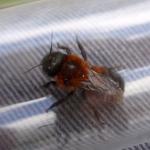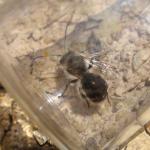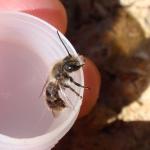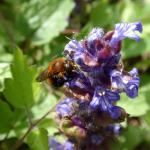As with other woodland insects, the fortunes of several bees have been adversely affected by modern woodland management - the abandonment of coppicing leading to stands of mature broadleaved trees or the establishment of coniferous plantations. Both these woodland types eventually shade out the understorey and its rich and varied herb communities. One bee adversely affected by such changes is Osmia pilicornis, though where suitable conditions exist it can still be locally common.
A paper describing the biology and habitat of this species Distribution, biology and habitat of the rare European osmiine bee species Osmia (Melanosmia) pilicornis (Hymenoptera, Megachilidae, Osmiini) by Rainer Prosi, Heinz Wiesbauer & Andreas Müller can be downloaded here
BWARS member Rosie Earwaker has produced:
- a fact sheet about O. pilicornis;
- a summary of the results of 2013 and 2014 surveys for O. pilicornis;
- A report on habitat assesment for O. pilicornis.
These can be downloaded from the links below:
This species is largely confined to deciduous woodland in southern England, from Kent to Cornwall (though it is very rare in the south-west), northwards to Hereford and Worcester and Suffolk. In Wales, known only from Mid Glamorgan. There are no records from the Channel Islands or Ireland. It is a scarce species, but is occasionally numerous in a few sites, e.g. woodland near Goodwood, West Sussex.
Listed as Nationally Notable (Na) (Falk 1991).
Open, broadleaved woodland, especially on chalky soils. In the spring both sexes can be found flying low over banks, paths and in coppiced clearings, the males usually appearing silvery and often difficult to follow (the colour of their body hairs rapidly fades after emergence). The species is sometimes found flying with Osmia bicolor.
A spring species, flying as a single brood from early April to the end of June, rarely July.
The nests are built in existing burrows in dead wood, including fallen branches (Chambers, 1949) and stumps. It is almost certain that both sexes overwinter as adults in their cocoons.
In Britain, the bee visits violets (Viola spp.), willows (Salix spp.), comfrey (Symphytum sp.) and self-heal (Prunella vulgaris), though it is not known if these are pollen sources. In Germany, the species is polylectic, visiting flowers in the families Boraginaceae, Fabaceae, Lamiaceae and Rosaceae (Westrich, 1989). The bee is, however, most strongly associated with bugle (Ajuga reptans). The unusual form of the galea (fringed with rows of strong, curved black setae) may be an adaptation for removing pollen from long, narrow flowers.
Profile written: 1998
Proofed: February 2012





